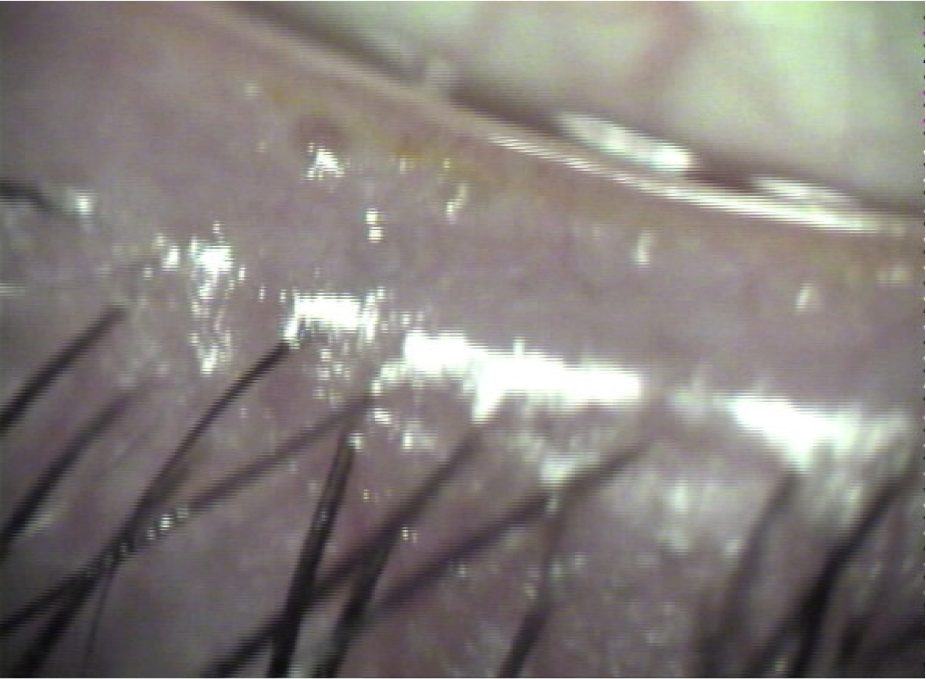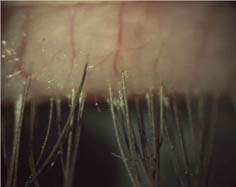Meibomian Gland Dysfunction - Signs & Symptoms
(Section 1)

Meibomian Gland Dysfunction is one of the leading causes of Dry Eye syndrome and often is a precursor to Posterior Blepharitis or Meibomitis (Meibomianitis). These terms are used semi-inter-changeably, with confusion often arising as a result. Anterior Blepharitis can occur with or without Posterior Blepharitis and Meibomian Gland Dysfunction affects mainly the anterior lid margin and lash follicles, often with a crusting at the base of the eyelashes. This usually has an infective component, often caused by staph. Aureus bacteria
.
The International workshop on Meibomian Gland Dysfunction (MGD) recently defined MGD as “a chronic diffuse abnormality of the Meibomian Glands, commonly characterised by terminal duct obstruction and/or qualitative /quantitative changes in the glandular secretion. This may result in the alteration of the tear film, symptoms of eye irritation, clinically apparent inflammation and ocular surface disease”. Generally Blepharitis is used to denote inflamed and infected, and usually blocked, meibomian glands.
There are approximately 30 Meibomian Glands in both the upper and lower eyelids. The meibomian glands of an unaffected person secrete a low viscosity lipid (oily) fluid into the tear film. This floats on top of the watery component of the tears reducing evaporation by “putting a “Lid” on the watery layer so reducing evaporative loss of water from the tears. Additionally it lubricates the surface of the eye.
The Meibomian Gland secretions are released into the tear film every time a blink occurs, as they lie surrounded by the orbicularis muscle that contracts each time a person blinks, squeezing the glands during this process, thereby expressing their contents
Meibomian Gland Dysfunction leads to evaporative dry eye signs and symptoms. When the Meibomian secretrions are deficient, water from the tears evaporates at an increased rate resulting in over-salty, or hypertonic tears
DIAG OF INC EVAP
One of the most significant consequences of this increased tear osmolarity or extra-salty tears, is that the surface of the eye loses water by osmosis to the more concentrated tear film. One of the most susceptible parts of the ocular surface to this damage caused by osmosis are the mucous secreting glands on the conjunctival surface, called Goblet Cells. Most of the Goblet cells lie on the “white of the eye” either side of the cornea. The mucous film that goblet cells secrete, coats the eye and “holds” the watery component of the tears in place, keeping the ocular surface hydrated and protected. So although the primary cause of the tear film change is excess evaporation due to reduced lipid secretions, the tear film instability is exacerbated by the consequent death of the mucous secreting goblet cells.
Dry eye specialist, Jeff Gilbard researched this problem for many years at the Schepens Eye Institute, and as a result developed a unique eye drop called Theratears, that mixed with the over-salty tears of the patient with evaporative dry eye to restore normal tear osmolarity, or saltiness. Fortunately when normal saltiness is restored to the tear film, goblet cells re-populate, with a consequent improvement in tear film thickness ensuing. This results in reduced signs and symptoms of dry eye.
Theratears drops also address other problems associated with dry eye, namely electrolyte imbalance and the increased friction between the eye-lid margin and the ocular surface (Lid-Wiper Epitheliopathy). In particular, there is an imbalance of the sodium and potassium levels afall in bicarbonate levels in dry eye that is addressed by the regular instillation of Theratears lubricant eye drops. The use of punctual plugs increases retention time of the Theratears drops, ensuring that their beneficial effects last for much longer.
The portion of the upper lid that is in contact with theocular surface is named the “Lid-Wiper” and “Lid-wper Epitheliopathy” is when this portion of the upper eyelid becomes traumatised and inflamed.
The symptoms of Meibomian Gland Dysfunction include:-
- Gritty, foreign body sensation
- Burning, hot feeling eyes
- Itching
- Watering
- Reduced or viariable vision

